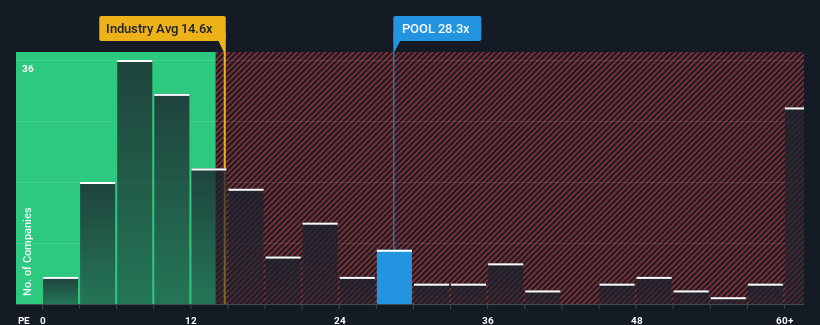- United States
- /
- Retail Distributors
- /
- NasdaqGS:POOL
Pool Corporation (NASDAQ:POOL) Investors Are Less Pessimistic Than Expected

When close to half the companies in the United States have price-to-earnings ratios (or "P/E's") below 16x, you may consider Pool Corporation (NASDAQ:POOL) as a stock to avoid entirely with its 28.3x P/E ratio. However, the P/E might be quite high for a reason and it requires further investigation to determine if it's justified.
While the market has experienced earnings growth lately, Pool's earnings have gone into reverse gear, which is not great. One possibility is that the P/E is high because investors think this poor earnings performance will turn the corner. You'd really hope so, otherwise you're paying a pretty hefty price for no particular reason.
View our latest analysis for Pool

How Is Pool's Growth Trending?
The only time you'd be truly comfortable seeing a P/E as steep as Pool's is when the company's growth is on track to outshine the market decidedly.
Retrospectively, the last year delivered a frustrating 29% decrease to the company's bottom line. Even so, admirably EPS has lifted 72% in aggregate from three years ago, notwithstanding the last 12 months. Accordingly, while they would have preferred to keep the run going, shareholders would probably welcome the medium-term rates of earnings growth.
Looking ahead now, EPS is anticipated to climb by 0.5% during the coming year according to the analysts following the company. With the market predicted to deliver 10% growth , the company is positioned for a weaker earnings result.
With this information, we find it concerning that Pool is trading at a P/E higher than the market. Apparently many investors in the company are way more bullish than analysts indicate and aren't willing to let go of their stock at any price. There's a good chance these shareholders are setting themselves up for future disappointment if the P/E falls to levels more in line with the growth outlook.
What We Can Learn From Pool's P/E?
While the price-to-earnings ratio shouldn't be the defining factor in whether you buy a stock or not, it's quite a capable barometer of earnings expectations.
We've established that Pool currently trades on a much higher than expected P/E since its forecast growth is lower than the wider market. Right now we are increasingly uncomfortable with the high P/E as the predicted future earnings aren't likely to support such positive sentiment for long. This places shareholders' investments at significant risk and potential investors in danger of paying an excessive premium.
Before you take the next step, you should know about the 1 warning sign for Pool that we have uncovered.
You might be able to find a better investment than Pool. If you want a selection of possible candidates, check out this free list of interesting companies that trade on a low P/E (but have proven they can grow earnings).
New: Manage All Your Stock Portfolios in One Place
We've created the ultimate portfolio companion for stock investors, and it's free.
• Connect an unlimited number of Portfolios and see your total in one currency
• Be alerted to new Warning Signs or Risks via email or mobile
• Track the Fair Value of your stocks
Have feedback on this article? Concerned about the content? Get in touch with us directly. Alternatively, email editorial-team (at) simplywallst.com.
This article by Simply Wall St is general in nature. We provide commentary based on historical data and analyst forecasts only using an unbiased methodology and our articles are not intended to be financial advice. It does not constitute a recommendation to buy or sell any stock, and does not take account of your objectives, or your financial situation. We aim to bring you long-term focused analysis driven by fundamental data. Note that our analysis may not factor in the latest price-sensitive company announcements or qualitative material. Simply Wall St has no position in any stocks mentioned.
About NasdaqGS:POOL
Pool
Distributes swimming pool supplies, equipment, related leisure, irrigation, and landscape maintenance products in the United States and internationally.
Excellent balance sheet average dividend payer.


